Introduction
Throughout history, societies have endeavored to create efficient educational systems. While countries like Finland have succeeded in striking the right balance, others continue to grapple with optimizing expenditure while achieving optimal results.
However, there is a consensus that a genuinely efficient educational system caters to students from diverse backgrounds—regardless of economic status, race, family history, or other differences. In such a system, every student is afforded equal opportunities to access the support and resources essential for their education. This fundamental concept embodies the essence of equity in education.
To support the school management in providing the equity in education, we had developed a platform called SETU that nurtures the students and improves academic performance.
This article will explore equity in education, its importance, promoting equity in the classroom and how to achieve equity in education.
What is equity in education?
Equity in education refers to providing fair and inclusive opportunities for all students to achieve their full educational potential, regardless of their background, circumstances, or characteristics. It aims to ensure that every student has access to the necessary resources, support, and quality education to succeed academically and personally. Equity recognizes that students have diverse needs and may require different levels of assistance and intervention to thrive in their learning journey.
The Organisation for Economic Cooperation and Development (OECD) identifies two closely intertwined dimensions of equity in education:
- Fairness: Educational equity seeks to eliminate discrimination and bias, ensuring that no student is disadvantaged or favored due to their race, ethnicity, gender, socioeconomic status, disability, language proficiency, or any other personal characteristic.
- Inclusivity: An equitable education system is inclusive, embracing and celebrating the diversity of students’ backgrounds, cultures, and experiences. It creates a learning environment where every student feels welcome, valued, and respected.
What is the role of equity in education
The role of equity in education is crucial and multifaceted. It plays a pivotal role in promoting fairness, social justice, and equal opportunities for all students in the educational system. Here are some key roles of equity in education:
- Fair Access to Education: Equity ensures that all students have equitable access to quality education, regardless of their background, socioeconomic status, ethnicity, or other personal characteristics. It aims to eliminate barriers preventing some students from accessing educational opportunities.
- Closing Achievement Gaps: Equity in education focuses on reducing and ultimately closing achievement gaps between different student groups. Providing targeted support to disadvantaged students seeks to ensure that every student has an equal chance to succeed academically.
Our platform SETU helps in providing the targeted support by identifying the learning gaps.
- Inclusivity and Diversity: Equity fosters an inclusive and diverse learning environment where all students feel valued, respected, and represented. It recognizes and celebrates the diverse backgrounds and perspectives that students bring to the educational setting.
- Addressing Systemic Inequalities: Equity in education addresses systemic inequalities in the education system. It advocates for fair distribution of resources, funding, and support to create a level playing field for all students.
- Social Mobility: Equity plays a vital role in promoting social mobility by providing equitable education opportunities. It enables students from disadvantaged backgrounds to break the cycle of poverty and improve their prospects.
- Empowering Marginalized Groups: Equity empowers marginalized groups by giving them a voice and ensuring their needs are met in the education system. It seeks to overcome historical and societal barriers that have hindered their educational progress.
- Creating a Just Society: Equity in education is intertwined with the principles of social justice. It aims to create a more just society where everyone has an equal opportunity to succeed and contribute meaningfully to the community.
- Economic Benefits: An equitable education system can benefit society economically. Access to quality education and the necessary skills contribute to a more productive and innovative workforce.
- Maximizing Human Potential: Education is a key factor in unlocking human potential. Equity ensures that every individual has the opportunity to develop their talents and abilities to the fullest extent possible.
- Promoting Global Competitiveness: Countries with equitable education systems are better positioned to compete globally. A well-educated and skilled workforce is essential for attracting investment and driving economic growth.
Promoting equity in the classroom:
Promoting equity in the classroom is essential to create an inclusive and supportive learning environment where every student has an equal opportunity to succeed.
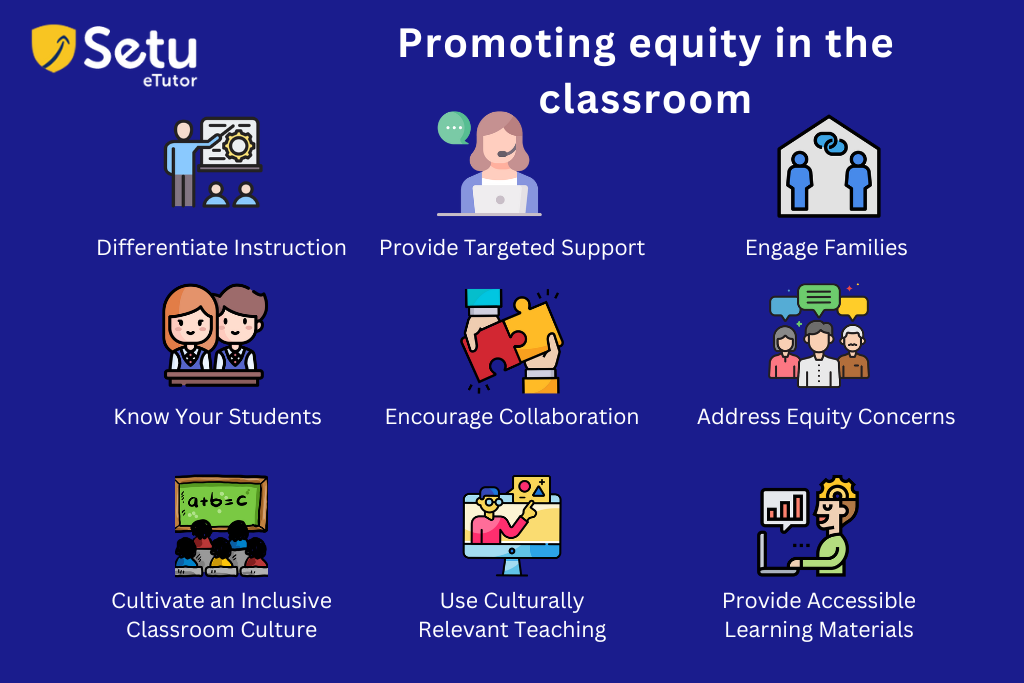
Here are some strategies that educators can implement to foster equity in the classrooms:
- Cultivate an Inclusive Classroom Culture: Create a classroom culture that values diversity and respects the backgrounds and experiences of all students. Encourage open discussions about different perspectives and foster an atmosphere of mutual respect.
- Know Your Students: Take the time to get to know your students individually. Understand their strengths, challenges, and interests. This knowledge will help you tailor your teaching approach to meet their diverse needs.
- Differentiate Instruction: Use a variety of teaching methods and materials to accommodate different learning styles and abilities. Differentiating instruction ensures that every student can engage with the content at their own pace and level.
- Provide Targeted Support: Identify students who may need extra support and offer targeted interventions to help them succeed. This could include one-on-one tutoring, additional resources, or specialized programs.
- Use Culturally Relevant Teaching: Incorporate culturally relevant teaching materials and examples that reflect the diverse backgrounds of your students. This approach helps students see themselves in the curriculum and feel more connected to the content.
- Encourage Collaboration: Foster a collaborative learning environment where students work together and learn from one another. Group activities can promote inclusivity and help break down social barriers.
- Provide Accessible Learning Materials: Ensure that all learning materials, including textbooks and online resources, are accessible to students with diverse abilities and learning needs.
- Address Equity Concerns: If you observe disparities in student outcomes, take proactive steps to address them. Engage with students, parents, and colleagues to collaboratively find solutions and support struggling students.
- Engage Families: Involve families in the learning process by maintaining open communication, inviting them to participate in school activities, and seeking their input on their child’s education.
Promoting equity in the classroom requires a continuous commitment to understanding and meeting the diverse needs of every student. By implementing these strategies, educators can create an inclusive and empowering learning environment that supports the success of all students.
How to achieve equity in education?
Achieving equity in education requires a collective effort and a sustained commitment to providing all students with equal opportunities to succeed. It is an essential step towards creating a more fair and inclusive society that empowers every individual to reach their full potential.
Here are some key strategies to work towards achieving equity in education:
- Identify Disparities: Begin by identifying and acknowledging disparities and inequities that exist within the education system. Analyze data on student outcomes, access to resources, and school funding to understand the areas that need improvement.
- Equitable Resource Allocation: Ensure that resources, funding, and support are distributed equitably among schools and districts. Schools serving disadvantaged students may require additional resources to address specific needs and bridge gaps.
- Culturally Responsive Teaching: Implement culturally responsive teaching practices that recognize and respect the cultural backgrounds and experiences of students. Incorporate diverse perspectives into the curriculum to make it more inclusive.
- Professional Development: Provide ongoing professional development for educators to help them understand and address equity issues in the classroom. Training can focus on identifying biases, adopting inclusive teaching strategies, and meeting the diverse needs of students
- Targeted Interventions: Develop targeted interventions and support systems for students who may be at a disadvantage. This could include tutoring programs, mentoring, or personalized learning plans.
- Parent and Community Engagement: Involve parents and the community in the education process. Create opportunities for families to participate in their child’s education, seek their input, and foster partnerships with community organizations to support student success.
Our technology-based platform comes with AI-based reminders that inform parents, students and teachers about student performance.
- Flexible Learning Environments: Create flexible learning environments that accommodate different learning styles and abilities. Offer a variety of instructional approaches and technologies to meet the needs of diverse learners.
- Data-Driven Decision Making: Use data to inform decision-making processes and monitor progress towards equity goals. Regularly assess student outcomes and adjust strategies accordingly.
- Addressing Systemic Barriers: Work to dismantle systemic barriers and practices that perpetuate inequities in education. This may involve policy changes, revision of school practices, and advocating for educational reform.
- Inclusive Policies: Advocate for inclusive policies at the district and national levels that prioritize equity in education. Work with policymakers to implement reforms that promote equal access to quality education.
- Continuous Improvement: Equity in education is an ongoing process. Continuously evaluate the effectiveness of strategies and initiatives, and be willing to adapt and refine approaches to achieve better outcomes.
At SETU platform, we help in achieving the continuous improvement in students through different assessment techniques and AI-based reminders.
Benefits of Focusing on Equity in Education
Equity in education offers a wide range of benefits that positively impact individuals, communities, and society as a whole.
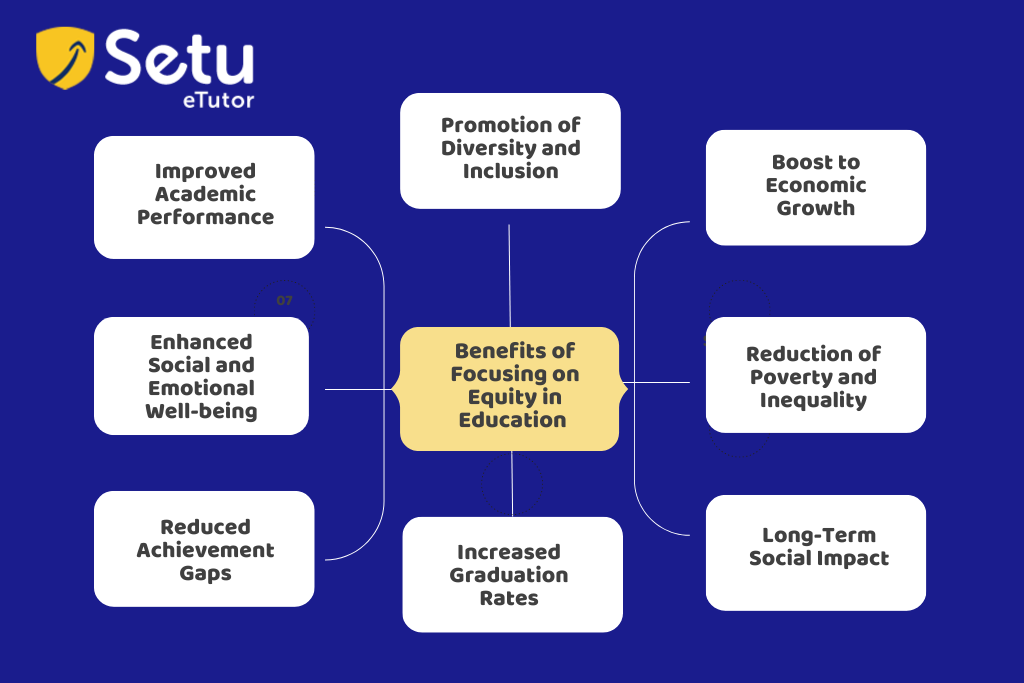
Some of the key benefits of promoting educational equity include:
- Improved Academic Performance: When students have access to equitable resources and support, their academic performance improves. By addressing barriers to learning, such as inadequate funding, lack of educational materials, and socio-economic disadvantages, students can focus more on their studies and achieve better educational outcomes.
- Reduced Achievement Gaps: Educational equity aims to narrow the achievement gaps between students from different backgrounds. By providing targeted support to disadvantaged students, these gaps can be reduced, ensuring that every student has the opportunity to succeed at their fullest potential.
- Enhanced Social and Emotional Well-being: Equitable education environments create a sense of belonging and inclusion for all students. When students feel valued and supported, they are more likely to have positive mental health, leading to increased overall well-being and a more positive learning experience.
- Increased Graduation Rates: Equity in education can lead to higher graduation rates. When students have access to the resources and support they need, they are more likely to stay engaged in their studies and complete their education successfully.
- Promotion of Diversity and Inclusion: Educational equity fosters a diverse and inclusive learning environment. By valuing and celebrating the differences among students, it promotes cross-cultural understanding and prepares students to thrive in a globalized world.
- Boost to Economic Growth: A well-educated population contributes to economic growth and prosperity. By providing equitable education opportunities, society can tap into the full potential of its human capital, leading to increased workforce productivity and innovation.
- Reduction of Poverty and Inequality: Equitable education can break the cycle of poverty by providing opportunities for upward mobility. When all students have access to quality education, they are better equipped to secure higher-paying jobs and improve their socio-economic status.
- Long-Term Social Impact: By investing in educational equity, societies can positively influence future generations. Equitably educated individuals are more likely to support their communities, challenge social injustices, and contribute to a more equitable society overall.
- Strengthening Democracy: A well-educated and informed citizenry is essential for a healthy democracy. Educational equity ensures that all citizens have access to the knowledge and skills needed to participate meaningfully in the democratic process.
Conclusion:
Equity in education is a vision of NEP 2020 where every individual is afforded equal opportunities to achieve their full potential and thrive academically and personally.
When educational systems prioritize equity, they can close achievement gaps, foster diversity and inclusion, and empower marginalized communities.
Ultimately, equity in education is a transformative force that not only shapes the future of individual learners but also has a profound impact on society as a whole. By embracing the principles of equity, we take a significant step towards building a fair, inclusive, and thriving global community.
To know more about how our SETU platform supports NEP 2020 in promoting equity in the classroom environment. Please get in touch with us to schedule a demo right now.






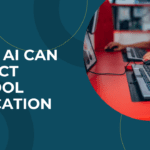
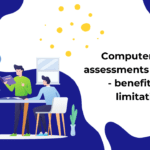
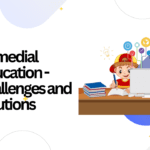
Leave a reply